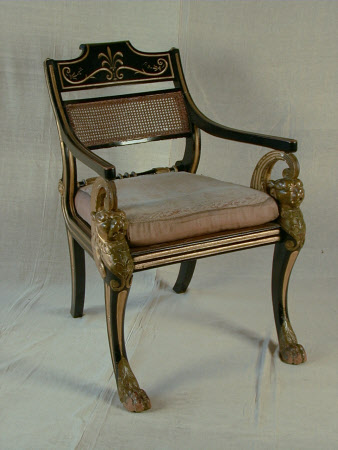Open armchair
manner of George Smith (London c.1786-1826)
Category
Furniture
Date
circa 1810
Materials
Painted and parcel gilt mahogany and beech, cane back, later ply seat, textile cushion
Measurements
85 x 63 x 55 cm
Place of origin
London
Order this imageCollection
Dyrham, Gloucestershire
NT 452960
Summary
An ebonised and parcel-gilt mahogany and beech open armchair, in the manner of George Smith, London circa 1810 The shaped curved top rail with acanthus and S-scroll carved detail above a caned panel and a horizontal turned and acanthus carved rail, the moulded arms with winged lion-mask monopodia supports above a later solid seat and sabre legs with paw feet. Stamped 'N.W.' to the seat frame, the seat originally caned.
Full description
The armchair is derived from published drawings by eminent Regency designers such as Thomas Hope (d.1831) through their patronage of the architect Charles Heathcote Tatham (d.1842). Its golden monopodia of winged-lion griffin derive from a marble antiquity acquired in the 1790s by Tatham (see C.H. Tatham, Etchings Representing the Best Examples of Ancient Ornamental Architecture, London, 1799). On this Grecian seat, such ornaments serve to recall the triumphal Mt. Parnassus chariot adopted by Apollo as poetry deity whose sacred sunflower enriches its scrolled tablet back, while its lyre form corresponds to the 'Apollo's Chair' pattern popularised by Thomas Sheraton's Encyclopaedia, 1804-7 (pl. 10). Prince George's 'Upholder Extraordinary' George Smith introduced the 'Tatham griffin' pattern in a 'Library Chair' pattern that he engraved in 1805 for 'A Collection of Designs for Household Furniture and Interior Decoration', London, 1808 (pl. 46). A identical chair with its original caned seat and also bearing the stamp 'N. W.' was sold Christies, London 17/11/2016 lot 108. This chair possibly belonged to the collection assembled around 1930 at the Crawford Street home of the fashionable architect and furniture designer Harry Stuart Goodhart Rendel (d.1959) and may be the chair illustrated in situ by C. Hussey, 'Four Regency Homes', Country Life, 1931, p. 454, fig. 10). Goodhart Rendel was one of a distinguished group of collectors that also included the diplomat and architect Lord Gerald Wellesley, later 7th Duke of Wellington, Edward Knoblock and Sir Albert Richardson, responsible for a revival in popularity of the Regency during the inter-war years. Letters in the National Trust archives: June 1960: Kenworthy-Browne writes to Mr. W A Fuller Esq, Brockbank, Shottermill Surrey to ask about a 2nd chair in his possession, and mention of a further found at the Antique Dealers Fair belonging to Temple Williams Ltd. Reply as follows dated July 1960: 'According to family tradition, the set were made for the Prince Regent but rejected by him, bought by my great great grandfather Matthew Corbett (1764-1846). They descended to his son Edward Corbett (1812 - 1897) my great grandfather who then divided them his children. My great aunt and uncles. My cousins Miss Corbett and Mrs E M Galloway of Bindham? have another of the chairs. I'm not sure what happened to the other chairs.' See also: Ralph Edwards, 'The Dictionary of English Furniture' rev. ed. Vol. I, London, 1954, p.312, fig. 282 Margaret Jourdain, 'Regency Furniture 1795-1830' London, 1965, p.50, fig. 82
Provenance
June 1960 the offer of a "fine Regency armchair" left by Dr. Catherine Louisa Corbett (No. 1 Falcondale Road, Westbury-on-Trym, Bristol) in her will. Claim to be owned by George IV. Bequest was dealt with by Lloyds Bank Ltd, Executors & Trustees Dept.
Marks and inscriptions
On under seat sail: N.W.
Makers and roles
manner of George Smith (London c.1786-1826), furniture designer
References
Edwards & Macquoid (1986), P. Macquoid & R. Edwards, The Dictionary of English Furniture (1986), p.312, fig. 282 Jourdain, Margaret,. Regency furniture 1795-1830 1965., p.50, fig. 82 Smith, George 'A collection of Designs for Household Furniture' London 1808, pl. 46
